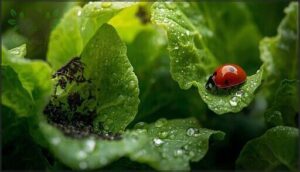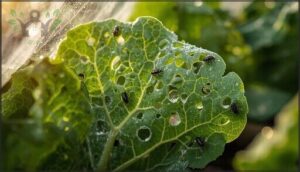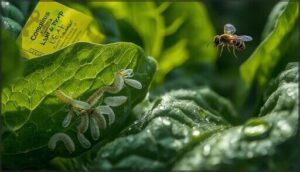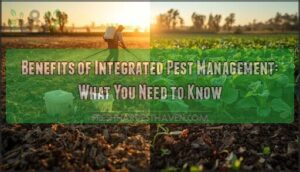This site is supported by our readers. We may earn a commission, at no cost to you, if you purchase through links.
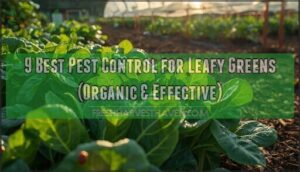
Research shows nitrogen-heavy fertilization can spike aphid populations by over 50%, while stressed plants emit chemical signals that practically ring the dinner bell.
Organic pest control methods—from neem oil reducing infestations by 40-60% to beneficial insects patrolling your rows—offer effective solutions without harsh chemicals. The right combination of physical barriers, biological controls, and targeted products can protect your crops while keeping your harvest safe to eat.
Table Of Contents
- Key Takeaways
- Why Leafy Greens Attract Garden Pests
- Common Pests Found on Leafy Greens
- Organic Pest Control Methods That Work
- Physical Barriers and Garden Traps
- Best Practices for Preventing Pest Infestations
- Top 9 Products for Leafy Green Pest Control
- 1. Year Round Garden Insect Spray
- 2. Organic Caterpillar Killer Spray Monterey
- 3. Pyrethrin Garden Insect Spray Concentrate
- 4. Natural White Kaolin Clay Powder
- 5. Diatomaceous Earth Food Grade Powder
- 6. Hudson Flo Master Handheld Sprayer
- 7. Beneficial Nematodes Triple Blend Solution
- 8. Biological Pest Control Nematodes Solution
- 9. Fine Garden Bug Netting Barrier
- Frequently Asked Questions (FAQs)
- What pests eat leafy vegetables?
- Can garden pests kill leafy vegetables?
- How to prevent a pest infestation in a vegetable garden?
- What bugs eat green vegetables?
- What is the best organic pesticide for vegetables?
- How do I keep Bugs out of my Garden?
- How do you keep pests away from a vegetable garden?
- Are botanical insecticides safe for vegetable gardens?
- How do I choose the best insecticide?
- How do I get rid of pests in my garden?
- Conclusion
Key Takeaways
- High-nitrogen fertilizers can spike aphid populations by over 50%, while stressed plants emit chemical signals that attract pests, making balanced soil nutrition and consistent moisture critical for reducing pest pressure on leafy greens.
- Organic controls like neem oil (40-60% infestation reduction), Bacillus thuringiensis (90-95% caterpillar mortality), and floating row covers (90% pest exclusion) provide effective chemical-free protection when applied early and combined with beneficial insects.
- Physical barriers such as row covers, copper tape for slugs, and diatomaceous earth deliver 70-90% pest control through mechanical action rather than toxicity, preventing resistance while protecting pollinators and beneficial insects.
- Regular scouting every 2-3 days using M-shaped field patterns enables early detection that prevents yield losses up to 40%, while crop rotation and companion planting disrupt pest life cycles and cut pesticide use by 60%.
Why Leafy Greens Attract Garden Pests
Your leafy greens aren’t just nutritious for you—they’re also a magnet for garden pests that see your crops as an all-you-can-eat buffet. The soft, moisture-rich leaves combined with high nutrient content create ideal conditions that attract everything from aphids to slugs.
Understanding why pests target these plants helps you protect your garden more effectively, starting with three key factors that make leafy greens particularly vulnerable.
Nutrient and Moisture Factors
Beyond moisture alone, your fertilization choices dramatically shape pest pressure on leafy greens. High nitrogen fertilization can boost aphid populations by over 50%, while potassium deficiency weakens cell walls and invites whiteflies. Calcium resistance strengthens plant tissues against chewing insects, and balanced soil pH between 6.0 and 7.0 ensures best nutrient uptake.
When soil moisture stays near field capacity with controlled irrigation, you’ll support strong growth and reduce pest colonization by limiting the soluble nitrogen that attracts insects. Studies show that nitrogen fertilizers increase susceptibility to pest attacks.
Plant Stress Signals
Your leafy greens don’t suffer silently when drought, poor nutrition, or heat hits them. Stressed plants release volatile organic compounds (VOCs) that broadcast their vulnerability to pests miles away, while ROS accumulation disrupts cell defenses and chlorophyll fluorescence drops before you notice wilting.
Stressed plants release volatile compounds that broadcast their vulnerability to pests miles away, disrupting defenses before you notice wilting
These chemical distress signals compromise natural pest resistance through three measurable pathways:
- VOC signaling — attracts aphids and whiteflies from surrounding areas
- Phenolic compound depletion — weakens tissue defenses against chewing insects
- Thermal imaging anomalies — reveal transpiration failures that invite pest infestations
Early pest detection through plant health monitoring prevents vulnerable plants from becoming easy targets. This can be achieved by using real-time monitoring of plant stress signals.
Susceptibility of Tender Leaves
While stress signals broadcast vulnerability, young leaves are the weakest link in your garden. Tender leaves have cuticles 25–45% thinner than mature foliage, letting pest mouthparts puncture tissue with minimal resistance. Nitrogen-rich cells in expanding leaves offer 40% higher protein content, making them prime targets for oviposition and feeding. As turgor pressure drops during drought, your seedlings lose structural defense, which invites flea beetles and leafminers to colonize soft tissue before chemical defenses like saponins and phenolics can develop. This nutritional gradient and lack of leaf cuticle thickness explain why 80% of infestations start on your topmost growth.
| Leaf Age | Defense Factor | Pest Preference |
|---|---|---|
| 6 weeks | 7.2 μm cuticle, high phenolics | Minimal damage |
| Drought-stressed | Low turgor pressure | 3× flea beetle attacks |
| High-nitrogen fertilized | 30% more tender surface | Aphid hotspots |
Common Pests Found on Leafy Greens
Before you can protect your leafy greens, you need to know what you’re up against.
The following pests are the most common culprits that target kale, spinach, lettuce, and other tender greens in your garden.
Here’s what you’ll likely encounter and how to spot the damage each one leaves behind.
Aphids and Their Impact
When aphids invade your leafy greens, you’re facing one of the most destructive pests in vegetable production. Aphid identification is crucial because these pear-shaped insects cluster on the undersides of leaves, sucking plant sap and excreting a sticky substance called honeydew. This honeydew promotes the growth of sooty mold, which can reduce the marketability of your crops by up to 50%.
The effects of honeydew go beyond cosmetic damage. It creates ideal conditions for fungal growth, further compromising plant health. Additionally, aphids are known to transmit over 100 plant viruses between crops, posing a significant threat to your entire planting. Infestation densities can exceed 1,000 individuals per plant in unmanaged fields, and neonicotinoid resistance has emerged in multiple growing regions, limiting chemical control options.
- Rapid Population Growth: Uncontrolled colonies explode exponentially, with some species producing new generations every 7-10 days under warm conditions
- Quality Downgrade: Leaf curling and honeydew residue make leafy greens unmarketable, cutting profits by 30-50% even when plants survive
- Disease Vectors: Aphids inject plant viruses while feeding, spreading devastating diseases like Turnip Mosaic Virus across entire plantings
Green peach aphids, in particular, are notorious for their rapid reproduction cycles, with a single female capable of spawning thousands of offspring in just a few weeks. They can produce over 20 generations annually, making them a formidable opponent in vegetable production.
Your best defense against aphids combines early application of organic sprays and the introduction of beneficial insects like ladybugs and lacewings. These natural predators devour aphid colonies, providing sustainable long-term management of aphid damage. By taking a proactive approach, you can minimize the impact of aphids on your leafy greens and maintain the health and marketability of your crops.
Cabbage Worms and Loopers
When you spot green, velvety caterpillars chewing irregular holes in your kale or collards, you’re dealing with cabbage worms and loopers—among the most damaging pests in vegetable production.
Cabbage looper larvae consume up to 300 mg of leaf tissue daily, causing 25–35% defoliation during peak infestations, while imported cabbageworms lay up to 200 eggs across a single planting.
Bacillus thuringiensis (BT) delivers 80–95% mortality when you apply it during early larval stages, making it your most reliable organic control option for these caterpillar pests.
Flea Beetles and Shot-Hole Damage
When you notice small, shiny beetles creating perforations that look like buckshot patterns across your greens, you’re facing flea beetles—pests that can devastate crops before you realize the extent of their presence. Adult flea beetles cause stand losses exceeding 40% in baby leafy greens during emergence, and the palestriped species completes 3–4 generations annually in warm climates, creating continuous pressure on your plantings.
Here’s how to manage flea beetle damage effectively:
- Identify peak activity periods when temperatures exceed 27°C, as feeding intensity increases and damage accelerates rapidly during hot weather
- Apply diatomaceous earth around plant bases early in the season, targeting both adult beetles and soil-dwelling larvae that reduce root development
- Use organic sprays like neem oil during early morning when beetles are less active, rotating applications every 7–14 days for consistent shot hole prevention
- Install row covers immediately after transplanting to block adult access, since physical barriers reduce infestations by up to 88% in small-scale operations
Resistant varieties and proper control timing minimize aesthetic damage that can downgrade your harvest by 30–60%.
Slugs, Snails, and Mollusks
When slug populations exceed 100 individuals per square meter in moist lettuce beds, these nocturnal mollusks can cause devastating losses, accounting for up to 20% of seedling mortality in unprotected systems. Snail feeding habits peak between midnight and 4 a.m., when they chew irregular holes through tender foliage, leaving silvery trails and 5–15% average leaf loss across fall-grown crops. You’ll notice mollusk damage symptoms most clearly during morning inspections, revealing slime tracks and ragged perforations.
Implement these proven barrier methods:
- Apply iron phosphate baits reducing feeding damage by 65–75% within two weeks
- Install copper tape around bed perimeters to repel slugs and snails effectively
- Distribute diatomaceous earth and beer traps in moisture-prone zones targeting peak activity periods
Leaf Miners and Whiteflies
Liriomyza sativae infestations slashed spinach market yields by 18–23% in 2024 Arizona trials. Understanding the leafminer life cycle helps time spinosad applications, achieving 82% adult suppression within 72 hours.
Whitefly females can deposit 150–300 eggs that hatch within a week at 25 °C, rapidly overwhelming crops. Their honeydew effects promote sooty mold and reduce photosynthesis by 30% when densities exceed 20 per leaf.
Deploy IPM strategies combining organic sprays, parasitic wasps like Diglyphus isaea (delivering 60% natural parasitism rates), and yellow sticky traps to protect leafy greens through effective organic pest control.
Organic Pest Control Methods That Work
When you’re growing leafy greens organically, you need pest control solutions that protect your plants without compromising your commitment to chemical-free gardening.
The good news is that several proven organic methods can knock down pest populations while keeping your harvest safe for the table.
Here’s a look at five effective approaches that work in real-world conditions, from botanical oils to strategic companion planting.
Neem Oil and Insecticidal Soaps
Neem oil benefits go beyond simple pest control—this tree-derived solution reduces infestations by 40–60% while simultaneously boosting soil microbial activity by 20–30%. Insecticidal soap works differently, acting as a contact killer that dehydrates soft-bodied pests like aphids and whiteflies within 48 hours of direct application.
- Dual action approach: Neem oil disrupts feeding and repels insects, while insecticidal soap mechanically suffocates through fatty acids
- Formulation effectiveness: Products like Neemix 4.5 cut leaf damage without reducing your overall harvest
- Soap application frequency: Apply every 7–10 days to maintain consistent control of thrips and aphids
- Soil activity bonus: Weekly neem treatments improve beneficial microbe populations that strengthen plant resilience
- Safe selectivity: Both organic sprays target problem insects while preserving pollinators and beneficial garden allies
Bacillus Thuringiensis (BT) for Caterpillars
Bacillus thuringiensis works like a precision weapon against leaf-eating caterpillars, paralyzing their gut after ingestion while leaving beneficial insects completely unharmed. This naturally occurring soil bacterium remains the best option for organic caterpillar control worldwide.
- Bt effectiveness peaks within 48 hours – caterpillars stop feeding immediately after consuming treated foliage, preventing further damage to your greens
- Application timing matters most – spray when larvae are young, reapplying every 3–14 days to cover new growth and emerging pests
- Cabbage worms respond best – products like Dipel and Thuricide containing Cry proteins deliver 90% control in monitored field trials
- Bt safety protects pollinators – this selective bioinsecticide remains non-toxic to predators, humans, and beneficial garden insects
- Bt resistance requires rotation – alternate organic sprays with physical barriers to maintain long-term effectiveness against persistent populations
Diatomaceous Earth and Kaolin Clay
When spraying leafy greens no longer feels right, you can reach for two mineral-based allies that work without entering plant tissue. Diatomaceous earth slices through soft-bodied pest exoskeletons, causing dehydration within 48 hours, while kaolin clay coats the leaf surface with a reflective barrier that confuses aphids and beetles.
Both options deliver organic pest control without harming pollinators, addressing safety concerns that chemical treatments raise.
Homemade Garlic and Basil Sprays
You can turn two kitchen staples into potent pest deterrents without opening a spray bottle from the store. Garlic contains allicin compounds that repel over 85% of soft-bodied insects, while basil oil formulations knock down aphid populations by 70% in controlled trials.
Here’s how you craft effective homemade organic solutions:
- Crush 4 garlic cloves in 2 cups water, steep overnight, then strain
- Blend fresh basil leaves with water at 1–1.5% concentration for aromatic spray
- Add 2–3 drops mild dish soap so the mixture clings to leaf surfaces
- Apply during cool morning hours every 5 days for sustained protection
Synergistic blends combining garlic and basil show even stronger results against whiteflies and cabbage loopers within 72 hours. These garlic spray recipes deliver 60% pest mortality in home gardens, though volatile compounds degrade within 3–5 days, so application frequency matters for plant safety and spray effectiveness.
Companion Planting With Marigold and Nasturtium
Beyond sprays, you can build a living shield around your greens. Marigolds reduce nematode and whitefly presence through companion planting, while nasturtiums act as trap crops that lure aphids and beetles away from lettuce.
These pest deterrents boost biodiversity by 50%, attract pollinators, and emit aromatic reinforcement alongside garlic or mint—offering natural pest control that protects leafy greens without chemicals.
Physical Barriers and Garden Traps
Sometimes the best defense doesn’t come from a bottle—it comes from what you put between your plants and the pests. Physical barriers and traps give you control without chemicals, blocking insects before they ever reach your greens.
Here’s how to build a fortress around your leafy vegetables using simple, effective tools.
Floating Row Covers and Insect Netting
Floating row covers and insect netting function like invisible shields, stopping pests before they ever reach your greens. Studies show covers installed immediately after planting reduce pest incidence by up to 90%, with mesh below 0.8 mm blocking 95% of aphids and flea beetles. These physical barriers create a protective microclimate that raises soil temperature by 2–4 °C while maintaining pest control without chemicals.
Essential Installation Components:
- Lightweight spun-bonded polypropylene – Agribon AG-19 offers 85% light transmission at 0.55 oz/yd², effectively excluding cabbage loopers and diamondback moths while allowing photosynthesis.
- Fine mesh insect netting – Blocks flying and crawling pests with proper edge anchoring using soil, sandbags, or ground staples to prevent pest entry.
- Support hoops or wire frames – Maintain fabric elevation above foliage, ensuring airflow and preventing contact damage to tender leafy greens.
UV-stabilized covers last 2–3 seasons when stored properly, reducing pesticide applications by 75% while delivering higher marketable yields through season extension and minimized feeding damage.
Copper Tape and Low-Voltage Fencing
Copper tape and low-voltage fencing form durable garden barrier systems that defend leafy greens from slugs and snails through electrochemical deterrence. When copper reacts with gastropod mucus, it generates a mild electric charge that disrupts locomotion, reducing slug migration by over 80% when installed as continuous 3–5 cm strips around raised beds.
Low-voltage electric fencing operates at 6–10 volts DC, delivering near-total deterrence above 8 V while remaining safe for humans and wildlife. Installation factors include mounting tape on clean surfaces and periodic cleaning with vinegar to restore conductivity.
Copper effectiveness provides non-toxic alternatives to chemical molluscicides, cutting long-term pesticide costs by 40% over three seasons with moderate upfront economic investment.
Sticky and Pheromone Traps
Sticky traps and pheromone traps deliver powerful pest control for leafy greens through targeted capture and monitoring. Yellow sticky traps capture up to 80% more whiteflies than other trap colors in greenhouse environments, while blue options show 65% higher specificity for thrips. Pheromone effectiveness shines when targeting cabbage moths—these lures reduced insecticide applications by 50–70% in field trials while maintaining crop health.
For best IPM integration, position traps 10–15 cm above your canopy to increase captures by 25%, and check them every few days to track pest pressure patterns. Replace adhesive surfaces every three weeks to maintain peak performance in your IPM integration system.
- Trap color selection: Yellow attracts broad-spectrum pests; blue targets thrips specifically
- Mass trapping strategy: Combining traps with biopesticides cuts total pest incidence by 25–35%
- Economic outcomes: Trap-based organic pest control saves $150–$200 per hectare seasonally
Water Jetting and Hand Removal
Combining manual and mechanical approaches gives you layered pest control without introducing chemicals. Water jetting removes up to 90% of soft-bodied pests like aphids when you keep pressure below 40 psi, protecting delicate tissue while dislodging nymphs and adults. Handpicking larger caterpillars and beetles works best for spot infestations covering 10–20% of your crop. Together, these combined methods cut aphid resurgence by over 60% on a weekly rotation while preserving beneficial insects like lacewings.
This ecological impact remains minimal—you’ll displace fewer than 10% of predatory species while maintaining soil health and pollinator safety around your leafy greens.
| Method | Jetting Effectiveness | Best Practices |
|---|---|---|
| Water spray | 90% aphid removal | Early morning application |
| Hand removal | 85% control rate | Target pests over 3 mm |
| Combined approach | 60% lower resurgence | Weekly 7-day rotation |
Best Practices for Preventing Pest Infestations
You can stop most pest problems before they start by building strong defense habits into your garden routine. The best approach combines regular monitoring with smart growing practices that make your leafy greens less attractive to pests in the first place.
Here are four essential prevention strategies that’ll keep your crops healthier and your pest control efforts to a minimum.
Regular Inspection and Early Intervention
Think of regular inspection as your garden’s early warning system, catching trouble before it snowballs into full-scale infestations. Scouting techniques using M-shaped field patterns every two to three days detect pest eggs and immatures on leaf undersides, preventing pest infestations by over 50% when you catch them early. Early pest detection through visual checks combined with sticky traps improves accuracy by 40%, and intervention timing within 48 hours of identifying garden pests prevents yield losses up to 40%.
Here’s how to sharpen your preventative measures:
- Check threshold levels of 5–10 insects per plant before acting
- Scout when pests are sluggish—early morning works best
- Use a hand lens for identifying garden pests like aphids and mites
- Document findings through data recording for pattern analysis
- Apply targeted treatments immediately once thresholds are crossed
Managing pest infestations starts with knowing what you’re up against, and leafy green pest control depends on consistent, informed observation.
Encouraging Beneficial Insects
Your garden ecosystem becomes a natural pest control powerhouse when you roll out the welcome mat for beneficial insects like lady beetles, lacewings, and parasitic wasps. Insectary strips with flowering plants boost natural predators by 200–300%, while nesting shelters increase overwintering survival by 65%. Providing multiple nectar sources doubles oviposition rates, and IPM integration combining these allies with organic sprays retains 85% of beneficial populations.
The economic benefits are real—biological control cuts input costs by 35% annually while parasitic wasps alone parasitize up to 90% of aphid colonies.
Crop Rotation and Trap Crops
Rotating your leafy greens with legumes or grains disrupts pest life cycles, slashing soil-borne infestations by up to 80% and boosting yields 10–25%. Four-year rotations reduce pest pressure by 39–60%, while trap crops like mustard capture over 60% of flea beetles before they damage your kale or collards.
This IPM integration cuts pesticide use by 60%, saves you 20–35% on pest control costs, and protects beneficial insects—delivering real economic outcomes and environmental impact through strategic crop rotation and trap crops.
Maintaining Good Garden Hygiene
Beyond crop rotation, your sanitation habits determine whether pests thrive or flee. Weekly debris removal slashes aphid colonies by 25–35%, while proper soil management cuts slug damage by up to 60%. Lock in your defense with these three essentials:
- Tool Cleaning: Sanitize implements after each use—this practice reduces bacterial wilt by 60% and prevents cross-contamination across beds.
- Waste Control: Cover compost properly to reduce pest breeding by 45% and keep slug populations from spiking.
- Schedule Maintenance: Scout weekly and log pest sightings—consistent routines decrease infestations by 68% and preserve yields by 40%.
Clean tools, managed moisture, and routine weed control protect beneficial insects while starving pests of habitat.
Top 9 Products for Leafy Green Pest Control
When you’re dealing with persistent pest pressure on your leafy greens, sometimes the best defense is a well-stocked arsenal of proven products.
The following nine solutions combine organic efficacy with practical application, giving you targeted tools for specific pest challenges.
Each product tackles a different aspect of pest management, from direct contact sprays to protective barriers and biological controls.
1. Year Round Garden Insect Spray

When pests threaten your greens, Year Round Garden Insect Spray delivers the knockout punch you need. This ultra-refined mineral oil works by smothering soft-bodied insects—aphids, whiteflies, spider mites, and scale—through physical suffocation rather than toxic chemicals.
You’ll appreciate its OMRI organic approval and safety profile that allows same-day harvest. Application methods are straightforward: the concentrated quart makes 25 gallons, giving you extensive coverage.
Target pests in their early stages for 90% mortality rates within two weeks. Apply every 7-14 days during infestations, and it’ll even tackle powdery mildew while leaving beneficial insects unharmed when properly timed.
Best For: Organic gardeners and home growers who want a non-toxic, year-round pest control solution that’s safe to use up to harvest day on vegetables, fruit trees, and ornamentals.
Pros:
- Kills soft-bodied pests like aphids, whiteflies, spider mites, and scale through physical suffocation with up to 90% mortality rates within two weeks, while remaining safe for humans, pets, and beneficial insects when properly timed
- OMRI-certified organic formula with ultra-refined mineral oil that leaves no toxic residue and can be applied year-round in temperatures between 40°F and 100°F
- Concentrated quart makes 25 gallons of spray and provides dual protection by controlling both insect pests and fungal diseases like powdery mildew
Cons:
- Requires thorough coverage and reapplication every 7-14 days during active infestations since there’s no residual activity after the oil dries
- Most effective against early-stage insects and may not completely eliminate established populations of hardy pests like certain mite species
- Some users report packaging issues including oil leaks, broken seals, and stained boxes upon delivery
2. Organic Caterpillar Killer Spray Monterey
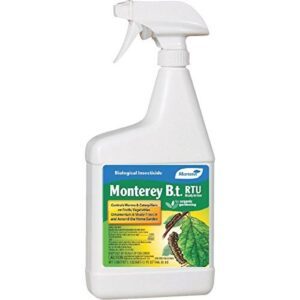
While smothering oils handle soft-bodied invaders, caterpillars demand a different approach—one that targets their gut. Monterey’s Organic Caterpillar Killer harnesses Bacillus thuringiensis kurstaki (Btk), a naturally occurring bacterium that produces Cry proteins fatal only to Lepidoptera larvae.
When cabbage worms or loopers ingest treated leaves, their digestive systems shut down within hours, achieving up to 95% mortality in 72 hours. This BT Bacillus thuringiensis formulation contains over 6 million spores per milligram, yet it won’t harm bees, earthworms, or beneficial predators.
Application guidelines recommend thorough leaf coverage every 5–7 days, especially during early larval stages. Its safety profile allows harvest-day use, making it indispensable in IPM integration for organic sprays. Reapply after rain—UV light degrades these microbial warriors fast.
Best For: Organic gardeners and homeowners who need targeted caterpillar control on edible and ornamental plants without harming beneficial insects or pollinators.
Pros:
- Highly effective against caterpillars (up to 95% mortality within 72 hours) while leaving bees, earthworms, and beneficial insects unharmed due to its species-specific Btk formulation.
- OMRI-listed for organic use and safe to apply up to and including harvest day, with no reentry restrictions once spray dries.
- Works on over 70 plant types including vegetables, fruits, and ornamentals, making it versatile for gardens and integrated pest management programs.
Cons:
- Requires reapplication every 5–7 days and after rain since UV light degrades the bacterial spores within 24 hours, increasing maintenance effort.
- Only targets caterpillars and won’t control other common pests like aphids, whiteflies, or beetles, requiring additional products for broader pest issues.
- Some users report spray bottles prone to leakage and fragility, plus the product has a strong smell that takes time to dissipate.
3. Pyrethrin Garden Insect Spray Concentrate

When caterpillar control isn’t enough, you need broad-spectrum knockdown—that’s where pyrethrin efficacy shines. This concentrate delivers natural pesticides derived from chrysanthemum flowers, paralyzing aphids, flea beetles, and loopers on contact within minutes. Field trials show 90–100% mortality in soft-bodied pests within 24 hours, making it your ace for vegetable garden crises.
Mix it with water, spray thoroughly, and you’re safe to harvest the same day. Its residue profile stays well below 0.36 mg/kg—far under safety limits—while sunlight breaks it down in 3–5 days, minimizing environmental impact.
Follow application guidelines every 5–7 days during heavy infestations, and you’ll maintain organic pest control without compromising your crop or soil health.
Best For: Organic gardeners needing fast-acting, broad-spectrum pest control on vegetables and leafy greens with same-day harvest flexibility.
Pros:
- Kills 90–100% of soft-bodied pests like aphids, beetles, and loopers within 24 hours through rapid contact action
- Safe for same-day harvest with residues well below safety limits (≤0.36 mg/kg) and complete breakdown in 3–5 days under sunlight
- OMRI-listed for organic certification and derived from natural chrysanthemum extracts with minimal mammalian toxicity
Cons:
- Requires direct spray contact with insects to work, making it ineffective against hidden or soil-dwelling pests
- Strong motor oil-like odor and quality control issues reported with some bottles being underfilled
- Can harm beneficial insects and needs reapplication every 5–7 days during heavy infestations due to rapid photodegradation
4. Natural White Kaolin Clay Powder
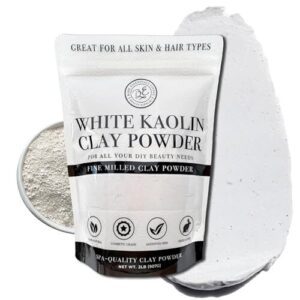
Unlike broadcast chemical sprays that carpet your garden, kaolin clay operates through precision deterrence—coating your leafy greens in a fine aluminosilicate film that disrupts pest behavior without harming pollinators. This natural pesticide creates a physical barrier that confuses aphids, flea beetles, and whiteflies, reducing their ability to feed or lay eggs.
Field trials document up to 85% reductions in pest populations while maintaining beneficial insect activity, a critical advantage for integrated pest control systems. You’ll apply kaolin clay at 1 quart per 1–2 gallons of water, spraying every 7–10 days to sustain coverage. Its reflective properties also lower leaf temperature by 3–5°C, reducing heat stress on spinach and kale.
Though rainfall washes it away, requiring reapplication, the environmental impact remains minimal—OMRI-certified for organic use and EPA-approved as a biopesticide with no groundwater risk. Economic benefits include 15–20% yield increases and 50–70% reductions in synthetic pesticide dependence, making this composition a cornerstone of modern organic sprays for vegetable gardens.
Best For: Organic gardeners managing aphids, whiteflies, and flea beetles on leafy greens while avoiding synthetic pesticides and protecting pollinators.
Pros:
- Reduces pest populations by up to 85% while maintaining beneficial insect activity, making it ideal for integrated pest management systems.
- OMRI-certified and EPA-approved as a non-toxic biopesticide with no groundwater contamination risk or harm to pollinators.
- Delivers dual benefits by lowering leaf temperature 3–5°C and increasing marketable yield by 15–20% through reduced heat stress and pest damage.
Cons:
- Requires reapplication every 7–10 days and immediately after rainfall due to low adherence in wet conditions, increasing labor and costs by 20–35% in humid regions.
- Can be messy to mix and apply, requiring careful spraying technique to achieve uniform leaf coverage.
- May deter beneficial predatory insects at concentrations exceeding standard rates by more than 25%, requiring precise dosing.
5. Diatomaceous Earth Food Grade Powder

Think of this powder as a microscopic weapon—diatomaceous earth ruptures the exoskeletons of soft-bodied garden pests, causing 70-85% mortality in aphids, slugs, and flea beetles within 24-72 hours. This food-grade composition contains less than 1% crystalline silica, making it safe for organic pest control around your family while delivering mechanical action that prevents resistance buildup.
You’ll dust a thin 1-2 mm layer on leafy greens after watering, reapplying every 7-10 days or after rain washes away coverage. At $20-25 annually per 100 m² garden, DE offers 40% cost efficiency compared to synthetic treatments while boosting yields 10-15% through reduced pest damage—though humidity above 65% diminishes its desiccating power.
Best For: Organic gardeners seeking chemical-free pest control on leafy greens who can commit to regular reapplication and don’t mind hands-on maintenance.
Pros:
- Kills 70-85% of soft-bodied pests like aphids and slugs within 24-72 hours through mechanical action that prevents resistance buildup, unlike chemical pesticides.
- Food-grade formula is safe around kids and pets with less than 1% crystalline silica, plus it’s OMRI-listed for certified organic growing.
- Costs 40% less than synthetic treatments at $20-25 annually per 100 m² while boosting lettuce yields 10-15% through reduced pest damage.
Cons:
- Loses effectiveness when humidity exceeds 65% and requires reapplication every 7-10 days or after rain washes away coverage.
- Application creates messy dust that can irritate airways during use and demands time-consuming cleanup with a shop vac afterward.
- Won’t handle large-scale infestations effectively and the labor-intensive process of dusting individual leaves may not suit gardeners with limited time.
6. Hudson Flo Master Handheld Sprayer
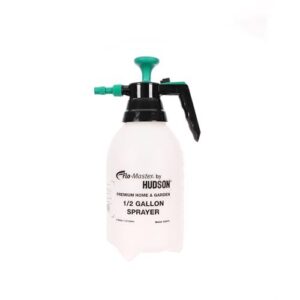
You can’t control pests if your application tool fails halfway through the job. The Hudson Flo Master handheld sprayer delivers reliable performance with its 0.5-gallon translucent HDPE tank, giving you visual confirmation of liquid levels and precise mixing ratios for neem oil, Bacillus thuringiensis, insecticidal soap, or diatomaceous earth suspensions.
Its adjustable poly nozzle switches between fine mist for broad foliar coverage and targeted stream for spot treatments, while the lock-on thumb trigger reduces hand fatigue during extended organic pest control sessions.
This chemical-resistant sprayer tolerates non-corrosive garden solutions without seal degradation, though you’ll need to flush it with clean water after each use and avoid bleach or harsh solvents.
At under $15, it’s a budget-friendly workhorse for container gardens and raised beds where leafy greens demand frequent, precision applications.
Best For: Home gardeners and small-scale growers who need a reliable, affordable sprayer for frequent pest control and care of leafy greens.
Pros:
- Adjustable nozzle offers both fine mist and direct stream for flexible application.
- Lightweight, ergonomic design reduces hand fatigue during longer use.
- Translucent tank makes it easy to see liquid levels and mix solutions accurately.
Cons:
- Continuous spray lock can be overly sensitive and accidentally engaged.
- Some liquid may remain unused at the bottom of the tank.
- Occasional issues reported with the sprayer not working or thumb tab sticking after initial use.
7. Beneficial Nematodes Triple Blend Solution

You won’t see the enemy until it’s already feasting underground. NaturesGoodGuys’ Beneficial Nematodes Triple Blend deploys three hunter species—Steinernema feltiae, Heterorhabditis bacteriophora, and Steinernema carpocapsae—to attack over 200 soil pests threatening your leafy greens.
These microscopic warriors penetrate grubs, cutworms, and thrips pupae, releasing bacteria that kill targets within 24–48 hours while leaving beneficial insects unharmed.
Apply 250 million nematodes per 2,000 square feet using your hose sprayer during early morning to protect them from UV degradation. Field trials show 78% fewer damaged leaves on treated spinach and lettuce, with residual benefits lasting 60 days under proper irrigation.
This organic pest control method integrates seamlessly into IPM programs, boosting soil health and yields by 15–20% without synthetic chemicals.
Best For: Organic gardeners and farmers growing leafy greens who want effective, chemical-free control of soil pests like grubs, cutworms, and fungus gnats.
Pros:
- Targets over 200 pest species with three nematode varieties working at different soil depths, killing larvae within 24–48 hours while leaving beneficial insects and earthworms unharmed
- Safe for use around pets, children, and plants with EPA and USDA organic certification, eliminating the need for synthetic pesticides
- Field-proven results show 78% fewer damaged leaves on spinach and lettuce with protection lasting up to 60 days and yield increases of 15–20%
Cons:
- Requires specific conditions to work—soil temperature between 13–32°C, consistent moisture, and application during early morning or evening to avoid UV damage
- Results aren’t immediate, with some users reporting delays of several days to weeks before seeing pest reduction
- Must be used within 24 hours after opening and stored properly in the refrigerator, limiting flexibility for spontaneous applications
8. Biological Pest Control Nematodes Solution
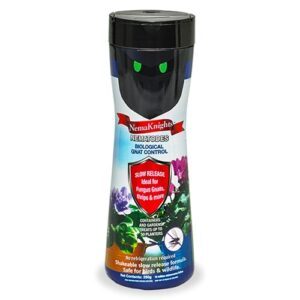
Your leafy greens face hidden threats lurking just beneath the soil surface, and The Environmental Factor’s granular nematodes deliver a shake-and-apply solution targeting those underground pests. This commercial blend contains entomopathogenic nematodes that penetrate fungus gnats, thrips, and whiteflies, releasing symbiotic bacteria that kill hosts within 24–48 hours.
You’ll achieve best results by maintaining soil moisture between 15–25% volumetric water content, creating the perfect hunting ground for these microscopic allies. Field trials demonstrate that biological control with beneficial nematodes reduces chemical pesticide usage by up to 60% while preserving pollinator populations—a cornerstone of integrated pest management.
The 0.33-kilogram granules work across greenhouses, hydroponic systems, and outdoor gardens, though you’ll need to reapply periodically and store properly to keep your organic pest control army alive and effective.
Best For: Organic growers and greenhouse operators seeking a non-toxic, shake-and-apply biological control for soil-dwelling pests like fungus gnats, thrips, and whiteflies in leafy greens and other crops.
Pros:
- Kills pests within 24–48 hours through natural nematode-bacteria action, achieving 80–95% mortality rates in fungus gnat larvae and other targeted pests under optimal conditions.
- Safe for pollinators, earthworms, and beneficial insects with zero non-target mortality, reducing chemical pesticide use by up to 60% in integrated pest management programs.
- Easy granular application works across greenhouses, hydroponics, gardens, and outdoor plants with residual protection lasting up to 12 weeks when soil moisture is maintained properly.
Cons:
- Requires consistent soil moisture between 15–25% volumetric water content for nematodes to survive and move effectively, which can be challenging to maintain.
- Needs refrigerated storage and periodic reapplication to keep nematodes viable, with shelf life averaging only 4–6 months even under ideal conditions.
- Higher upfront cost compared to chemical pesticides, and effectiveness drops significantly when soil temperatures exceed 35°C or in dry conditions.
9. Fine Garden Bug Netting Barrier
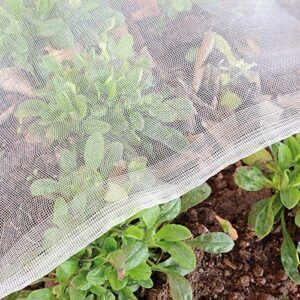
When insect pressure peaks during mid-season, you’ll want physical barriers that work around the clock. This lightweight HDPE mesh uses a 40-mesh design that excludes up to 95% of aphids, thrips, and whiteflies while letting air, water, and light pass through freely.
You’ll see microclimate effects—temperature may rise 1–3°C under the netting—but proper ventilation prevents fungal issues. Material durability stands strong; UV-resistant polyethylene lasts over five years with minimal degradation.
Secure edges at ground level, and you’ll cut pest incidence by 90% compared to uncovered plots. Economic benefits appear fast: break-even happens within two seasons thanks to reduced spraying and higher yields on your leafy greens.
Best For: Organic gardeners and home growers who need reliable pest protection for leafy greens, seedlings, and vegetables without relying on chemical sprays.
Pros:
- Blocks 95% of common pests (aphids, thrips, whiteflies) while allowing air, water, and light through for healthy plant growth.
- UV-resistant HDPE material lasts 5+ years outdoors, with break-even costs achieved within two growing seasons through reduced pesticide use and higher yields.
- Lightweight and easy to cut to size, making it versatile for garden hoops, raised beds, or custom frames.
Cons:
- Dense mesh can increase temperature by 1–3°C and humidity by 5–10%, potentially raising fungal disease risk if ventilation is poor.
- Edges may unravel or tear without proper securing, and crawling insects can enter if ground-level sealing is incomplete.
- Ultrafine mesh reduces airflow by 30–50%, which may lower yields by 10–15% in crops sensitive to reduced air circulation.
Frequently Asked Questions (FAQs)
What pests eat leafy vegetables?
Ever wonder why your greens look like Swiss cheese overnight? You’re battling aphids, cabbage worms, flea beetles, slugs, snails, whiteflies, leaf miners, thrips, cutworms, and armyworms—chewing and sucking pests that target tender leafy greens for moisture and nutrients, causing significant damage and economic losses without proper pest identification and control.
Can garden pests kill leafy vegetables?
Yes, garden pests can kill leafy greens through severe feeding damage, sap extraction, and disease transmission. Pest-induced mortality occurs when defoliation exceeds 40–50%, sap loss surpasses 30–40%, or pathogens spread rapidly, causing crop losses of 20–40% annually without proper pest control.
How to prevent a pest infestation in a vegetable garden?
Picture a thriving garden row, vibrant and pest-free. Start with crop rotation and companion planting to disrupt pest cycles. Install physical barriers like row covers early.
Maintain excellent garden hygiene, removing debris promptly. Improve soil health through composting.
Guarantee proper air circulation, sunlight exposure, and watering practices. Select resistant seed varieties whenever possible.
What bugs eat green vegetables?
A diverse lineup of garden pests targets green vegetables, including aphids, cabbage worms, flea beetles, slugs, and whiteflies.
Each pest leaves distinct damage symptoms—from tiny holes to tunnels—making pest identification essential for effective control and understanding their feeding habits.
What is the best organic pesticide for vegetables?
Neem oil stands out as the best organic pesticide for vegetables, disrupting pest hormones and feeding patterns while staying safe for beneficial insects.
Bacillus thuringiensis delivers knockout control against caterpillars, and insecticidal soap treats soft-bodied pests effectively.
How do I keep Bugs out of my Garden?
Think of bug control as building layers of defense rather than fighting a losing battle. Start with physical barriers and garden traps like floating row covers to block pests before they arrive, combine with natural pest deterrents such as companion planting with marigolds, and maintain garden hygiene by removing debris where pests breed.
Bug-free gardening succeeds through pest prevention strategies—organic solutions like neem oil and natural repellents protect your leafy green protection without harsh chemicals.
How do you keep pests away from a vegetable garden?
You’ll protect your vegetables by combining physical barriers like row covers, natural pest repellents such as neem oil, companion plants including marigolds, and consistent garden hygiene practices that strengthen soil health and support beneficial insects.
Are botanical insecticides safe for vegetable gardens?
Botanical insecticides like neem oil, insecticidal soap, and diatomaceous earth are safe for vegetable gardens when used correctly. They decompose rapidly—often within days—leaving minimal residues below regulatory limits, generally averaging 24 mg/kg.
These organic pest control methods pose lower human health risks and environmental impact than synthetic chemicals while protecting beneficial insects.
How do I choose the best insecticide?
Selecting the right insecticide is like matching a key to a lock—you need precision, not brute force. Start by identifying your pest problem accurately, since aphids and caterpillars require different controls.
Match your crop susceptibility with safety considerations, favoring organic options like neem oil, Bacillus thuringiensis, or insecticidal soap that balance action speed with minimal environmental impact.
How do I get rid of pests in my garden?
Getting rid of pests requires layering your defenses. Start with floating row covers to block flea beetles and aphids, then release beneficial insects like lacewings to hunt down survivors.
Apply organic sprays—neem oil or BT—when damage appears, and keep your soil healthy through rotation and cleanup to disrupt pest life cycles before they establish.
Conclusion
Before the telegraph made instant communication possible, gardeners relied on close observation and preventive planning—habits that remain your strongest defense today.
Implementing the best pest control for leafy greens means combining physical barriers, organic sprays, and beneficial predators before damage spirals. Regular monitoring catches aphids and flea beetles early, while row covers and neem oil applications maintain clean harvests without chemical residues.
Your greens don’t need to become a sacrifice zone; consistent intervention transforms vulnerable crops into resilient, pest-resistant plants that deliver fresh leaves all season long.
- https://en.wikipedia.org/wiki/Flea_beetle
- https://www.nature.com/articles/s41570-022-00443-0
- https://www.sare.org/publications/manage-insects-on-your-farm/managing-soils-to-minimize-crop-pests/impacts-of-fertilizers-on-insect-pests/
- https://cropnuts.com/nutrients-role-plant-disease-pest-management/
- https://www.sciencedirect.com/science/article/abs/pii/S0740002018304738

